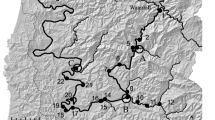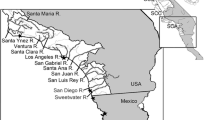Abstract
Invasive species with migratory behavior and complex life cycles represent a challenge for evaluating natal sites among individuals. Private and government-sponsored initiatives resulted in the successful introduction and naturalization of Chinook salmon (Oncorhynchus tshawytscha) throughout northern and southern Patagonia in South America. Migratory populations of Chinook salmon breed in fresh water, but spend most of their life feeding at sea, forming abundant populations in several watersheds draining into the southeast Pacific Ocean. We used single nucleotide polymorphisms combined with genetic structure and mixed-stock analyses to evaluate natal sites of Chinook salmon at sea caught in one estuary and two coastal locations compared to reference populations from breeding sites in fresh water. Firstly, Bayesian individual-assignment analyses revealed no genetic structure among adults caught off the coast of the Toltén River and migrating (maturing) adults caught in Toltén River estuary, suggesting they likely belong to a single population. Secondly, mixed-stock genetic analyses revealed that most Chinook salmon caught in one estuary and two coastal locations likely originated from spawners from the nearest river (86–96%). Contributions from distant watersheds to mixtures at sea decreased with increasing geographic distance. Our combined genetic evidence points strongly to homing among non-native Chinook salmon, whereby most adults return to breed to their natal river amid potentially long-distance migrations through the coast. Mixed-stock genetic analyses provide considerable potential to identify the population of origin of Chinook salmon mixtures caught off the coast. They also seem an appropriate proof of concept to assess homing versus dispersal and infer invasion pathways via long-distance migration.



Similar content being viewed by others
References
Anderson EC, Waples RS, Kalinowski ST (2008) An improved method for predicting the accuracy of genetic stock identification. Can J Fish Aquat Sci 65:1475–1486
Barrett SCH (2015) Foundations of invasion genetics: the Baker and Stebbins legacy. Mol Ecol 24:1927–1941
Bellinger MR, Banks MA, Bates SJ et al (2015) Geo-referenced, abundance calibrated ocean distribution of Chinook salmon Oncorhynchus tshawytscha stocks across the west coast of North America. PLoS ONE 10:e0131276
Bradbury IR, Hamilton LC, Chaput G et al (2016) Genetic mixed stock analysis of an interceptory Atlantic salmon fishery in the Northwest Atlantic. Fish Res 174:234–244
Brodeur RD (1990) A synthesis of the food habits and feeding ecology of salmonids in marine waters of the North Pacific Fisheries Research Institute, University of Washington, Seattle (INPFC Doc.) FRI-UW-9016, pp 1–38
Bustos CA, Landaeta MF, Balbontín F (2008) Efectos ambientales sobre la variabilidad espacial del ictioplancton de Chile austral durante noviembre de 2005. Reva Chil Hist Nat 81:205–219
Chown SL, Hodgins KA, Griffin PC et al (2015) Biological invasions, climate change and genomics. Evol Appl 8:23–46
Correa C, Gross MR (2008) Chinook salmon invade southern South America. Biol Invasions 10:615–639
Correa C, Moran P (2017) Polyphyletic ancestry of expanding Patagonian Chinook salmon populations. Sci Rep 7:14338
Crommenacker J, Bourgeois YXC, Warren BH et al (2015) Using molecular tools to guide management of invasive alien species: assessing the genetic impact of a recently introduced island bird population. Divers Distrib 21:1414–1427
Daly EA, Brodeur RD, Weitkamp LA (2009) Ontogenetic shifts in diets of juvenile and subadult coho and Chinook Salmon in coastal marine waters: important for marine survival? Trans Am Fish Soc 138:1420–1438
Darling JA, Folino-Rorem NC (2009) Genetic analysis across different spatial scales reveals multiple dispersal mechanisms for the invasive hydrozoan cordylophora in the Great Lakes. Mol Ecol 18:4827–4840
Gomez-Uchida D, Ernst B, Aedo G et al (2016) Informe Final FIP 2014-87: Estudio biológico pesquero y sanitario de la población de Salmón Chinook en la cuenca del Rio Toltén. Subsecretaría de Pesca y Acuicultura; Fondo de Investigación Pesquera y Acuicultura, p 420. http://www.subpesca.cl/fipa/613/articles-89445_informe_final.pdf
Gomez-Uchida D, Cañas-Rojas D, Riva-Rossi CM et al (2018) Genetic signals of artificial and natural dispersal linked to colonization of South America by non-native Chinook salmon (Oncorhynchus tshawytscha). Ecol Evol 8:6192–6209
Healey M (1991) Life history of Chinook salmon (Oncorhynchus tshawytscha). In: Groot C, Margolis L (eds) Pacific salmon life histories. UBC Press, Vancouver, pp 311–394
Jakobsson M, Rosenberg NA (2007) CLUMPP: a cluster matching and permutation program for dealing with label switching and multimodality in analysis of population structure. Bioinformatics 23:1801–1806
Jombart T, Devillard S, Balloux F (2010) Discriminant analysis of principal components: a new method for the analysis of genetically structured populations. BMC Genet 11:94
Liotta J (2019) Surprising record of a Chinook salmon Oncorhynchus tshawytscha (Walbaum, 1792) from the Paraná river delta in San Pedro, Buenos Aires, Argentina. Ichthyol Contrib Peces Criollos 63:1–4
McKinney GJ, Seeb JE, Seeb LW (2017) Managing mixed-stock fisheries: genotyping multi-SNP haplotypes increases power for genetic stock identification. Can J Fish Aquat Sci 74:429–434
Moran BM, Anderson EC (2018) Bayesian inference from the conditional genetic stock identification model. Can J Fish Aquat Sci 76:551–560
Narum SR, Gallardo P, Correa C et al (2017) Genomic patterns of diversity and divergence of two introduced salmonid species in Patagonia, South America. Evol Appl 10:402–416
Pritchard JK, Stephens M, Donnelly P (2000) Inference of population structure using multilocus genotype data. Genetics 155:945–959
Quinn T (2005) The behavior and ecology of Pacific salmon and trout. University Press, Seattle, p 320
R Core Team (2018) R: a language and environment for statistical computing. R Foundation for Statistical Computing. http://www.R-project.org/
Riddell BR, Brodeur RD, Bugaev AV et al (2018) Ocean ecology of Chinook salmon. In: Beamish RJ (ed) The ocean ecology of Pacific salmon and trout. American Fisheries Society, Bethesda, pp 555–696
Riva Rossi CM, Ma Pascual, Aedo Marchant E et al (2012) The invasion of Patagonia by Chinook salmon (Oncorhynchus tshawytscha): inferences from mitochondrial DNA patterns. Genetica 140:439–453
Sakai AK, Allendorf FW, Holt JS et al (2001) The population biology of invasive species. Annu Rev Ecol Syst 32:305–332
Seeb J, Pascal C, Ramakrishnan R et al (2009) SNP genotyping by the 5′-nuclease reaction: advances in high throughput genotyping with non-model organisms. In: Komar A (ed) Methods in molecular biology, single nucleotide polymorphisms, 2nd edn. Humana Press, New York, pp 277–292
Smith MJ, Pascal CE, Grauvogel Z, Habicht C, Seeb JE, Seeb LW (2011) Multiplex preamplification PCR and microsatellite validation enables accurate single nucleotide polymorphism genotyping of historical fish scales. Mol Ecol Resour 11:268–277
Trudel M, Fisher J, Orsi JA et al (2009) Distribution and migration of juvenile Chinook salmon derived from coded wire tag recoveries along the continental shelf of western North America. Trans Am Fish Soc 138:1369–1391
Weitkamp LA (2010) Marine distributions of Chinook salmon from the west coast of North America determined by coded wire tag recoveries. Trans Am Fish Soc 139:147–170
Acknowledgements
We are indebted to Cristian Canales-Aguirre, Pablo Rivara, Diego Cañas, Mauricio Cañas, Francisca Valenzuela-Aguayo, and Francisco González (“Don Quete”) for their substantial contribution to sample collection. Carita Pascal performed all laboratory analyses, including SNP genotyping, allele scoring, and database management. Recommendations from two anonymous referees greatly improved earlier manuscript versions. This research was supported by Núcleo Milenio INVASAL funded by Chile’s government program, Iniciativa Cientifica Milenio from Ministerio de Economia, Fomento y Turismo, and Chile’s government Grants, FONDECYT 1130807, 1191256, and FIPA 2014-87. Student support came from CONICYT 21160640 doctoral scholarship to SSM. SN also acknowledges funding from COPAS Sur-Austral ANID PIA APOYO CCTE AFB170006.
Author information
Authors and Affiliations
Corresponding author
Additional information
Publisher's Note
Springer Nature remains neutral with regard to jurisdictional claims in published maps and institutional affiliations.
Electronic supplementary material
Below is the link to the electronic supplementary material.
Rights and permissions
About this article
Cite this article
Musleh, S.S., Seeb, L.W., Seeb, J.E. et al. Mixed-stock analyses of migratory, non-native Chinook salmon at sea and assignment to natal sites in fresh water at their introduced range in South America. Biol Invasions 22, 3175–3182 (2020). https://doi.org/10.1007/s10530-020-02319-0
Received:
Accepted:
Published:
Issue Date:
DOI: https://doi.org/10.1007/s10530-020-02319-0




